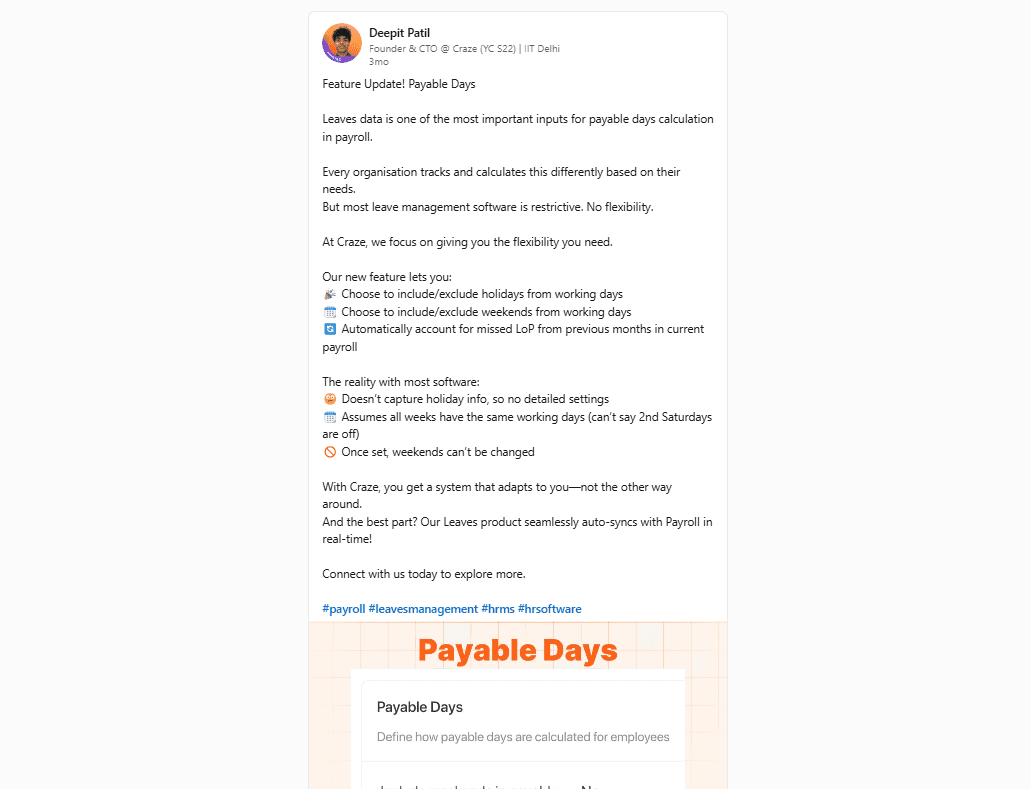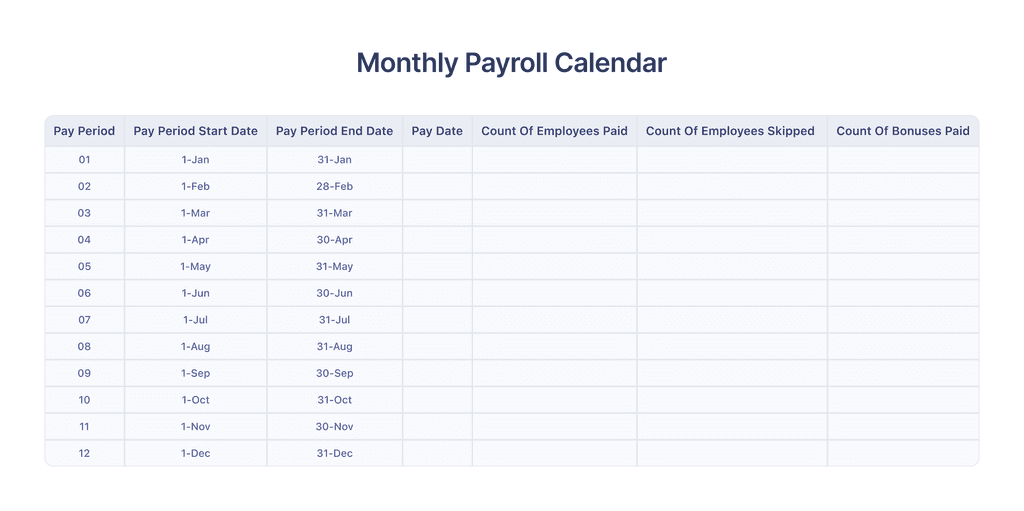The Ultimate Guide to Payroll Calendar in 2024: Everything You Need to Know
Imagine this: payday is approaching, and you are still counting hours, taxes, and deductions while employees wait to receive that ‘Salary credited’ message.
Have you ever faced this?
This is likely without a payroll calendar.
You miss deadlines, and your payroll estimations are full of errors, leading to a frustrated workforce. No wonder this frustration affects your team’s productivity.

Whether you are a startup founder doing payroll management by yourself or a human resource (HR) / finance manager trying to streamline the payroll process, using a paycheck calendar is a blessing in disguise.
A payroll calendar clarifies and streamlines your payroll lifecycle, from planning to execution. This step-by-step guide will help you create a payroll calendar from scratch.
You can also download our paycheck calendar template to get started.
What is a Payroll Calendar?
A payroll calendar outlines key dates and details, such as payment processing, the start and end of the pay period, and public holidays.
A payroll calendar helps HR and finance teams plan and schedule payment processes for timely and smooth payroll operations. It ensures employees get paid on time and with the right amount. It also helps them stay on track with taxation and banking dates to stay compliant and avoid last-minute hassles.
Why Do You Need a Payroll Calendar?
Missed, delayed, or incorrect payroll processing frustrates employees and affects a brand's reputation. Irrespective of the size of the company, you need a payroll calendar to ensure:
Timely payroll processing and payments
Imagine your employees not receiving their salaries and employee benefits on time. This could cause frustration and dissatisfaction. A well-maintained paycheck calendar helps make payments promptly, keeping morale high and avoiding disruptions. A payroll calendar also helps ensure compliance by tracking essential dates and deadlines, reducing the risk of fines and legal issues.

Better planning for system maintenance
Regular updates and maintenance of payroll systems are necessary. A payroll calendar helps schedule these activities around payroll processing dates to minimise potential disruptions.
More efficient use of human resources
HR teams can more effectively plan their tasks with a paycheck calendar. Knowing the schedule in advance allows them to allocate resources efficiently and ensure all payroll-related activities are completed on time.
Must-Have Elements in a Payroll Calendar
A comprehensive payroll calendar should include the following:
Start and end of the pay period, for example, from August 15 to August 29
Payroll processing date on which payroll is processed, preferably several days before payday
Pay date when employees receive their pay, such as August 31 or September 1
Pay frequency and how often employees are paid (weekly, bi-weekly, monthly, etc.)
Deadlines for timesheet submissions clarifying when timesheets are due, ensuring timely collection of all necessary data
Additional details, such as employee bank details

Types of Payroll Calendars
Businesses can choose from several types of payroll calendars based on their needs:
Weekly Payroll Calendar: Employees are paid weekly, e.g., every Friday. This type of paycheck calendar works well for organisations with hourly employees and a fluctuating workforce.
Bi-Weekly Payroll Calendar: Employees receive pay every two weeks, e.g., on the 1st and 15th of each month. This might suit companies who hire frequently for shorter periods.
Semi-Monthly Payroll Calendar: Employees are paid twice a month, e.g., on the 7th and 21st of each month. This payroll is better suited for small businesses with benefits deductions who wish to simplify their payroll process.
Monthly Payroll Calendar: This is the most commonly used method where employees receive pay once a month, e.g., on the last business day of the month.
On-Demand Pay Schedule: Employees can request payment whenever they need it. It usually comes with a flat rate fee and is uncommon or circumstantial.

Steps to Create a Payroll Calendar
Here is a guide to help you build a payroll calendar that not only keeps your payroll operations on track but also enhances overall efficiency:
Decide and set up pay frequency
Start by deciding how often you will pay your employees - weekly, bi-weekly, semi-monthly, or monthly. Consider legal regulations, employment type (e.g., salaried employees, contractual or freelancers), HR capacity, payroll team, and accounting.
Mark the holidays
Identify public and bank holidays and plan around them. For example, if a pay date falls on a national holiday, schedule the payment earlier to avoid delays.
Identify key dates
Note important dates like pay dates and timesheet deadlines to keep everything on track, like:
Pay Period Start Date
Pay Period End Date
Payday
Timesheet Submission Deadline
Payroll Processing Deadline
Tax Deposit Deadline
Tax Filing Deadline
List required information
Payroll is an ongoing process that includes attendance and leave management, overtime, tax withholding, and deductions. To streamline the entire process, you need accurate details for fair calculations, like:
Timesheet details
Tax implications
Banking details
Communicate with employees
Share the paycheck calendar with employees so they know payment schedules and deadlines for payroll submissions. In case of delays due to holidays, inform the employees beforehand.
Set up reminders
Use reminders to track important tasks, such as gathering payroll data or notifying the bank of salary transfers. This can be done through payroll software or calendar apps.
Use payroll software for automation
A payroll software like Craze can streamline payroll calendars and processing. You can automate payroll tasks and set up reminders, schedule notifications for reminders, and automate salary calculations and tax implications. This helps reduce errors and ensure timely processing.

Best Practices for Using a Payroll Calendar
To ensure that your payroll calendar gives you a clear idea of your payroll schedules, follow these best practices:
Conduct regular audits
Regular audits are necessary to ensure your payroll system is accurate and reliable. Regularly reviewing payroll processes and records will enable you to notice any disparities or compliance issues before they become major problems.
For instance, an auditor can detect tax withholding errors or employee hours discrepancies, enabling you to fix the problem and avoid paying fines.
You can do this by:
Scheduling regular audits– monthly or quarterly– to ensure accuracy and compliance
Cross-checking payroll records and timesheets, tax documents, and agreements to check for discrepancies such as incorrect hours and tax errors
Using systems that create detailed audit trails of payroll activities to track changes and find anomalies like unapproved changes, duplicate payments, and variations in pay rates
Employee self-service option
Allow employees access to payroll details. When employees can access their payroll information online, they can quickly review their payments, monitor their deductions, and change personal data.
Besides reducing questions and changes for the HR department, direct access to critical information instantly increases employee satisfaction so they know accurately when they are being paid.
You can achieve this by:
Providing a secure, user-friendly portal for employees to find information on and track pay, leaves, and benefits
Providing clear instructions on how to use the platform, update and understand the payroll information
Backup and contingency planning
Technology glitches and unexpected problems, like bank server crashing, can stall payroll processing. A contingency plan will enable you to continue processing payroll promptly. If, for instance, your payroll software stops working, a backup manual system will still allow you to pay employees and maintain business as usual.
Double-check information
Verifying payroll details before making payments helps to avoid mistakes that can result in incorrect pay cheques or compliance problems. This involves verifying hours worked, pay rates, tax deductions, and bank account information. With verification, you can avoid overpaying, underpaying, or neglecting to deduct an amount.
Verify recorded hours against timesheets and ensure rates match the agreements
Verify tax deductions, benefit contributions, and withholding amounts to avoid compliance issues
Ensure the bank account information of employees is correct
Send out the calendar
Giving out the payroll calendar beforehand lets employees better plan their money and schedules. It also gives HR and money teams enough time to fix issues or make necessary changes. Sending it out early helps stop last-minute shocks and ensures everyone knows the key dates and deadlines. While sharing the calendar, ensure:
Marking important dates such as paydays, tax deadlines and submission deadlines clearly
Communicating changes or updates promptly and keeping all stakeholders in the loop
Set up information meetings
Having meetings to explain the payroll calendar helps employees, especially new joiners, get the schedule and any changes that might affect them. Answer any questions the staff may have, show you care about their worries, and want to fix problems right away.
Hold employees accountable
Key to running payroll is ensuring workers stick to the pay schedule and meet due dates, like turning in timesheets when they should. To ensure employees stay accountable:
Communicate the consequences of missing payroll deadlines, such as delayed payments
Use automated reminders and regular check-ins to prompt employees to submit timesheets and finish necessary tasks before the due date

Seek Feedback and Adapt
Ask employees to give feedback on the payroll process and adapt useful suggestions to the payroll to maintain efficiency.
Common Challenges with Payroll Calendars
Managing payroll calendars can come with its own set of challenges. Here are some common issues and how to address them:
Dealing with public holidays and weekends
Plan effectively to manage the payroll if the planned dates fall on weekends and official holidays. For example, in the case of payroll, if the pay date is a weekend, prepare the payroll several days ahead to meet the deadlines. Mark all public holidays and weekends and schedule the payroll processing at least one or two days before to deal with hold-ups.

Handling payroll adjustments and corrections
Payroll adjustments or corrections may be necessary due to calculation errors or employee information changes. To manage this:
Regularly review payroll data for discrepancies like incorrect hours, deductions, or pay rates
Inform employees of adjustments and ensure they understand the changes to their pay
Correct the errors in the payroll system like adjusting wages, updating benefits, or tax corrections
Keep a detailed record of all the adjustments for auditing and future reference
Verify compliance with labour laws
Managing different payroll schedules
It is possible that different employees could earn different forms of pay, which may influence their payroll frequency. For instance, a company with hourly and salaried employees must manage different payrolls. To manage this:
Segment your calendar by frequency—weekly, bi-weekly, semi-monthly, or monthly
Set clear deadlines for submission and processing
Communicate the different pay structures and employee’s pay cycles
Coordinate with other departments to enhance the payroll schedules' efficiency and accuracy
Leverage payroll software to automate this entire process
Managing payroll on a spreadsheet can be a straightforward solution for small teams, but it comes with manual data entry errors, scheduling difficulties, and no integration with other HR Software.
Conclusion
Setting up and maintaining a payroll calendar is not for the faint-hearted. It is impossible to manage it all within a spreadsheet. That is why you need an HRMS platform like Craze by your side.
Craze is the appropriate tool for you if:
You are planning to build payroll operations from scratch in your organisation and looking for a unified platform to track HR, IT and finance together
You are frustrated with the current HR and payroll solutions in the market, as most of these tools are expensive and don’t provide access to all the advanced features
You are seeking an empathetic support team that genuinely cares about your problems
Want to see how Craze’s payroll software works?
FAQs
What is the payroll cycle period?
The payroll cycle period starts from the first day of the pay period and lasts until the last day. It helps to control the payment frequency and time procedures for employers. For example, if you set a bi-weekly payroll cycle, it means the period is two weeks, and employees are paid after every two weeks.
What is payroll scheduling?
Payroll scheduling is choosing specific dates for issuing paychecks or electronic payments. This means coordinating when timesheets are due, when and how payrolls are run, and when employees should expect their pay.
Is there an automated way to process payroll?
Yes, you can use software to automate the payroll process. A tool helps eliminate errors, streamlines the process, sends reminders, makes tracking easy, and maintains detailed records.
How often should a payroll calendar be reviewed and updated?
It is wise to revise your payroll calendar at least once a year or when there is a change in legislation or company laws. This prevents the calendar from being stale and unfit for use due to expired or outdated information.
What should be done if a payroll date falls on a public holiday?
Adjust your processing schedule and process payroll in advance to ensure timely payments if a pay date coincides with a public holiday.
Is it necessary to have a separate payroll calendar for contract employees?
Having a separate payroll calendar for contract employees is often beneficial, as they may have different payment schedules or compliance requirements than full-time employees. This helps ensure all employees are paid accurately and on time. Using a tool to maintain separate calendars helps exponentially, as it reduces the overhead of creating and following separate calendars.

